belt BUICK RANDEZVOUS 2002 Owner's Manual
[x] Cancel search | Manufacturer: BUICK, Model Year: 2002, Model line: RANDEZVOUS, Model: BUICK RANDEZVOUS 2002Pages: 455, PDF Size: 2.86 MB
Page 8 of 455
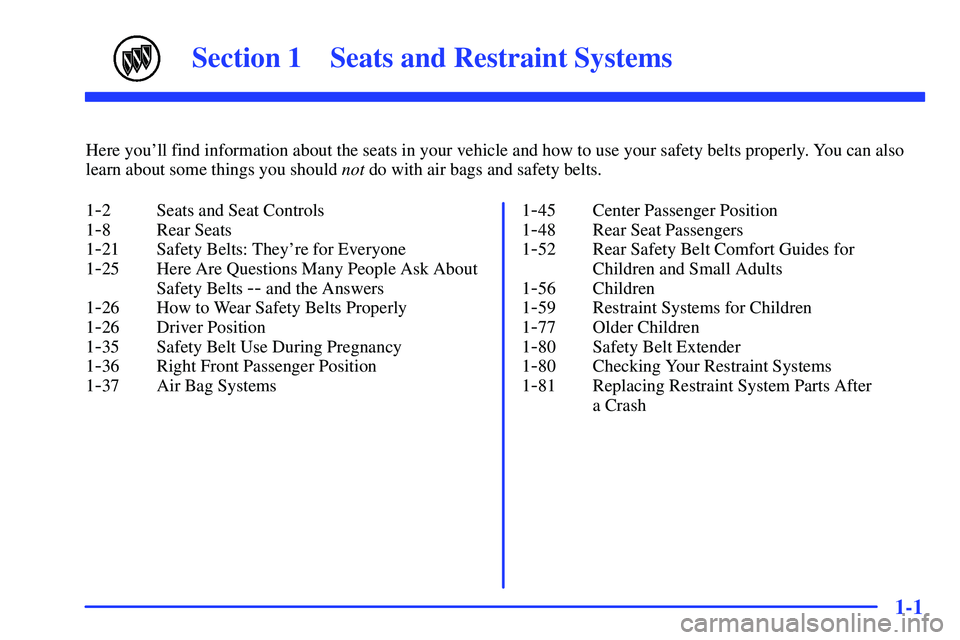
1-
1-1
Section 1 Seats and Restraint Systems
Here you'll find information about the seats in your vehicle and how to use your safety belts properly. You can also
learn about some things you should not do with air bags and safety belts.
1
-2 Seats and Seat Controls
1
-8 Rear Seats
1
-21 Safety Belts: They're for Everyone
1
-25 Here Are Questions Many People Ask About
Safety Belts
-- and the Answers
1
-26 How to Wear Safety Belts Properly
1
-26 Driver Position
1
-35 Safety Belt Use During Pregnancy
1
-36 Right Front Passenger Position
1
-37 Air Bag Systems1
-45 Center Passenger Position
1
-48 Rear Seat Passengers
1
-52 Rear Safety Belt Comfort Guides for
Children and Small Adults
1
-56 Children
1
-59 Restraint Systems for Children
1
-77 Older Children
1
-80 Safety Belt Extender
1
-80 Checking Your Restraint Systems
1
-81 Replacing Restraint System Parts After
a Crash
Page 14 of 455
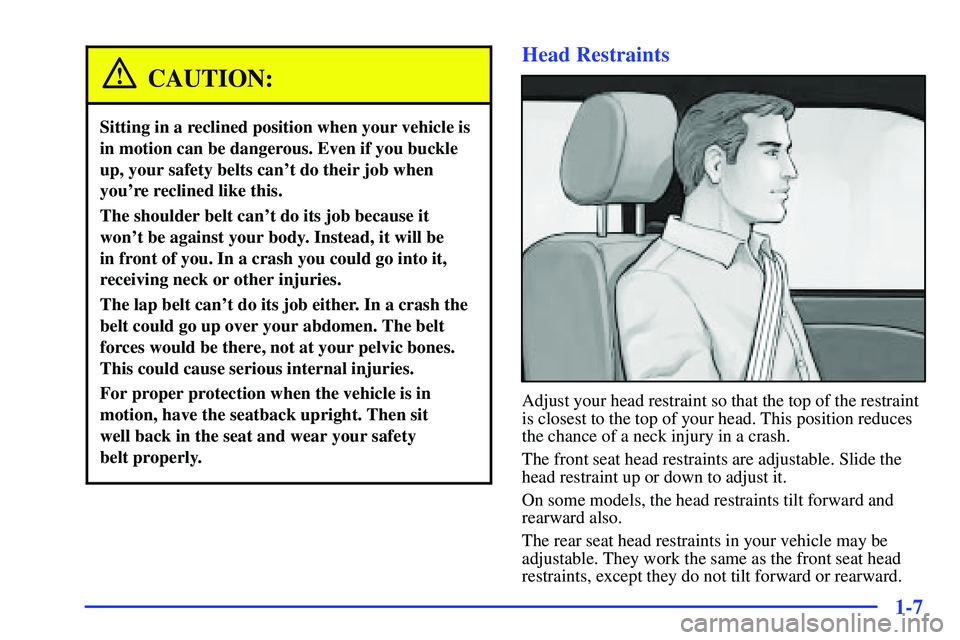
1-7
CAUTION:
Sitting in a reclined position when your vehicle is
in motion can be dangerous. Even if you buckle
up, your safety belts can't do their job when
you're reclined like this.
The shoulder belt can't do its job because it
won't be against your body. Instead, it will be
in front of you. In a crash you could go into it,
receiving neck or other injuries.
The lap belt can't do its job either. In a crash the
belt could go up over your abdomen. The belt
forces would be there, not at your pelvic bones.
This could cause serious internal injuries.
For proper protection when the vehicle is in
motion, have the seatback upright. Then sit
well back in the seat and wear your safety
belt properly.
Head Restraints
Adjust your head restraint so that the top of the restraint
is closest to the top of your head. This position reduces
the chance of a neck injury in a crash.
The front seat head restraints are adjustable. Slide the
head restraint up or down to adjust it.
On some models, the head restraints tilt forward and
rearward also.
The rear seat head restraints in your vehicle may be
adjustable. They work the same as the front seat head
restraints, except they do not tilt forward or rearward.
Page 17 of 455
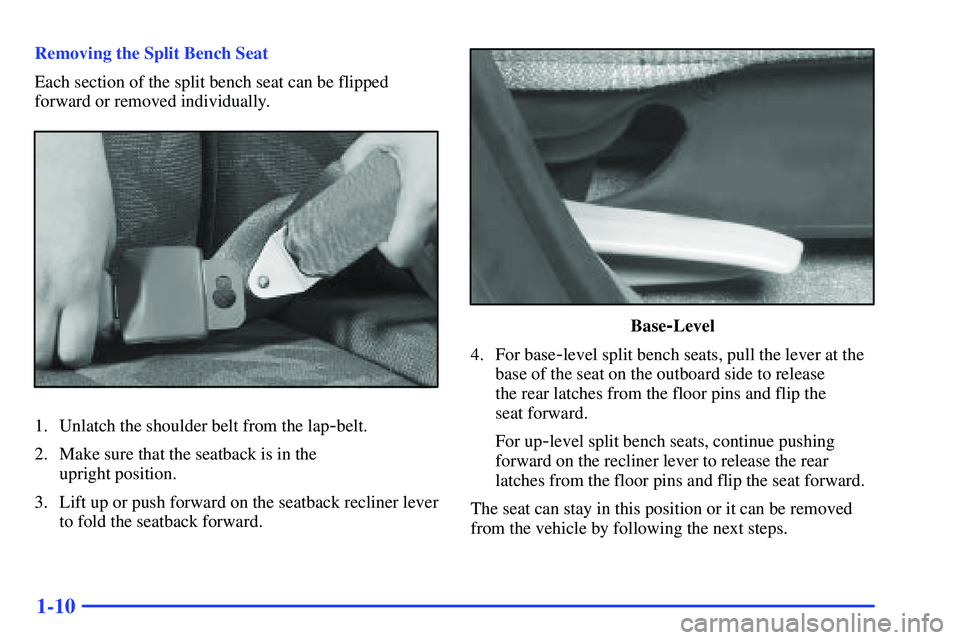
1-10
Removing the Split Bench Seat
Each section of the split bench seat can be flipped
forward or removed individually.
1. Unlatch the shoulder belt from the lap-belt.
2. Make sure that the seatback is in the
upright position.
3. Lift up or push forward on the seatback recliner lever
to fold the seatback forward.
Base-Level
4. For base
-level split bench seats, pull the lever at the
base of the seat on the outboard side to release
the rear latches from the floor pins and flip the
seat forward.
For up
-level split bench seats, continue pushing
forward on the recliner lever to release the rear
latches from the floor pins and flip the seat forward.
The seat can stay in this position or it can be removed
from the vehicle by following the next steps.
Page 19 of 455

1-12
CAUTION:
A safety belt that is improperly routed, not
properly attached, or twisted won't provide
the protection needed in a crash. The person
wearing the belt could be seriously injured.
After installing the seat, always check to be
sure that the safety belts are properly routed
and attached, and are not twisted.
Make sure that the seatback is in the folded forward
position and that the safety belts are on the correct
section of the seat.
Don't put the sections of the bench seat in so that they
face rearward because they won't latch that way.
The split bench seat sections have seat position labels,
located on the back of each section, showing where
the section must go.
The seat must be placed in the proper location for
the legs to attach correctly.
1. Squeeze the angled latch release bar toward the
straight crossbar while placing the front hooks of
the bench seat onto the front two floor pins.
Page 20 of 455
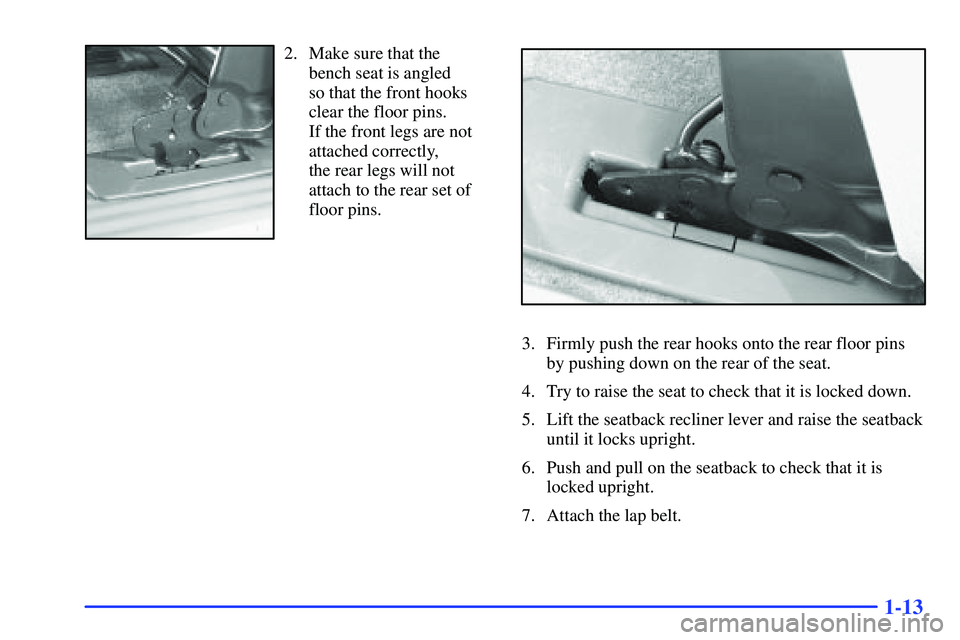
1-13
2. Make sure that the
bench seat is angled
so that the front hooks
clear the floor pins.
If the front legs are not
attached correctly,
the rear legs will not
attach to the rear set of
floor pins.
3. Firmly push the rear hooks onto the rear floor pins
by pushing down on the rear of the seat.
4. Try to raise the seat to check that it is locked down.
5. Lift the seatback recliner lever and raise the seatback
until it locks upright.
6. Push and pull on the seatback to check that it is
locked upright.
7. Attach the lap belt.
Page 23 of 455

1-16
Replacing the Captain's Chairs
CAUTION:
If the seatback isn't locked, it could move forward
in a sudden stop or crash. That could cause injury
to the person sitting there. Always press rearward
on the seatback to be sure it is locked.
CAUTION:
A seat that isn't locked into place properly
can move around in a collision or sudden stop.
People in the vehicle could be injured. Be sure
to lock the seat into place properly when
installing it.
CAUTION:
A safety belt that is improperly routed, not
properly attached, or twisted won't provide
the protection needed in a crash. The person
wearing the belt could be seriously injured.
After installing the seat, always check to be
sure that the safety belts are properly routed
and attached, and are not twisted.
Make sure that the seatback is in the folded forward
position and that the safety belts are on the correct side
of the chair.
Don't put the chairs in so that they face rearward
because they won't latch that way.
The captain's chairs have seat position labels, located
on the back of each section, showing where the section
must go.
The seat must be placed in the proper location for the
legs to attach correctly.
Page 28 of 455

1-21
Safety Belts: They're for Everyone
This part of the manual tells you how to use safety belts
properly. It also tells you some things you should not
do with safety belts.
And it explains the air bag system.
CAUTION:
Don't let anyone ride where he or she can't wear
a safety belt properly. If you are in a crash and
you're not wearing a safety belt, your injuries
can be much worse. You can hit things inside the
vehicle or be ejected from it. You can be seriously
injured or killed. In the same crash, you might
not be if you are buckled up. Always fasten your
safety belt, and check that your passengers' belts
are fastened properly too.
CAUTION:
It is extremely dangerous to ride in a cargo area,
inside or outside of a vehicle. In a collision,
people riding in these areas are more likely
to be seriously injured or killed. Do not allow
people to ride in any area of your vehicle that is
not equipped with seats and safety belts. Be sure
everyone in your vehicle is in a seat and using a
safety belt properly.
Your vehicle has a light
that comes on as a reminder
to buckle up. See ªSafety
Belt Reminder Lightº in
the Index.
In most states and Canadian provinces, the law says to
wear safety belts. Here's why: They work.
Page 29 of 455

1-22
You never know if you'll be in a crash. If you do have
a crash, you don't know if it will be a bad one.
A few crashes are mild, and some crashes can be so
serious that even buckled up a person wouldn't survive.
But most crashes are in between. In many of them,
people who buckle up can survive and sometimes walk
away. Without belts they could have been badly hurt
or killed.
After more than 30 years of safety belts in vehicles,
the facts are clear. In most crashes buckling up does
matter ... a lot!Why Safety Belts Work
When you ride in or on anything, you go as fast as
it goes.
Take the simplest vehicle. Suppose it's just a seat
on wheels.
Page 32 of 455
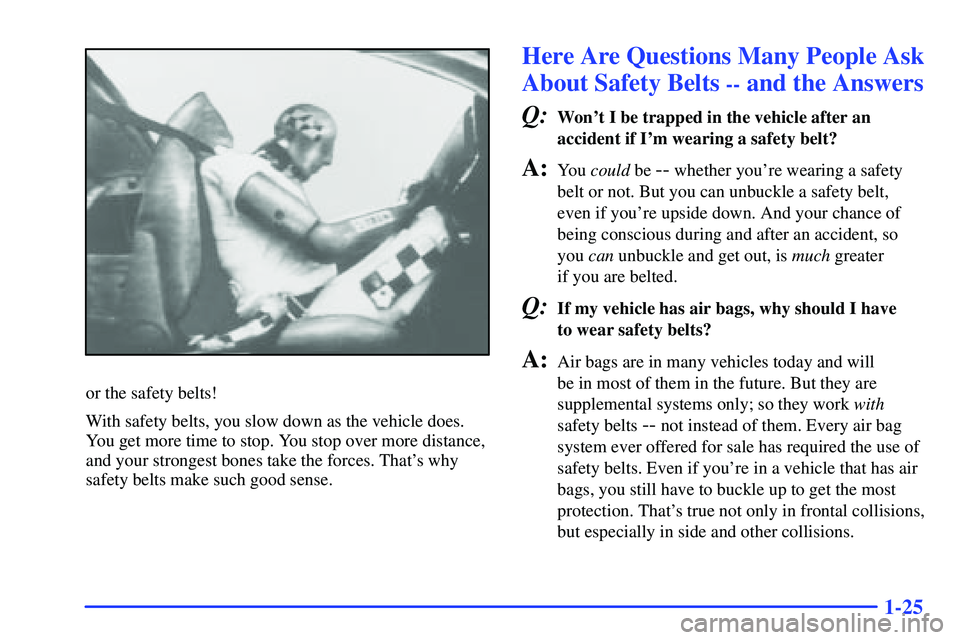
1-25
or the safety belts!
With safety belts, you slow down as the vehicle does.
You get more time to stop. You stop over more distance,
and your strongest bones take the forces. That's why
safety belts make such good sense.
Here Are Questions Many People Ask
About Safety Belts
-- and the Answers
Q:
Won't I be trapped in the vehicle after an
accident if I'm wearing a safety belt?
A:You could be -- whether you're wearing a safety
belt or not. But you can unbuckle a safety belt,
even if you're upside down. And your chance of
being conscious during and after an accident, so
you can unbuckle and get out, is much greater
if you are belted.
Q:If my vehicle has air bags, why should I have
to wear safety belts?
A:Air bags are in many vehicles today and will
be in most of them in the future. But they are
supplemental systems only; so they work with
safety belts
-- not instead of them. Every air bag
system ever offered for sale has required the use of
safety belts. Even if you're in a vehicle that has air
bags, you still have to buckle up to get the most
protection. That's true not only in frontal collisions,
but especially in side and other collisions.
Page 33 of 455

1-26
Q:If I'm a good driver, and I never drive far from
home, why should I wear safety belts?
A:You may be an excellent driver, but if you're in an
accident
-- even one that isn't your fault -- you
and your passengers can be hurt. Being a good
driver doesn't protect you from things beyond your
control, such as bad drivers.
Most accidents occur within 25 miles (40 km)
of home. And the greatest number of serious
injuries and deaths occur at speeds of less than
40 mph (65 km/h).
Safety belts are for everyone.
How to Wear Safety Belts Properly
Adults
This part is only for people of adult size.
Be aware that there are special things to know about
safety belts and children. And there are different rules
for smaller children and babies. If a child will be riding
in your vehicle, see the part of this manual called
ªChildren.º Follow those rules for everyone's protection.
First, you'll want to know which restraint systems your
vehicle has.
We'll start with the driver position.
Driver Position
This part describes the driver's restraint system.
Lap-Shoulder Belt
The driver has a lap-shoulder belt. Here's how to wear
it properly.
1. Close and lock the door.
2. Adjust the seat so you can sit up straight.
To see how, see ªSeatsº in the Index.